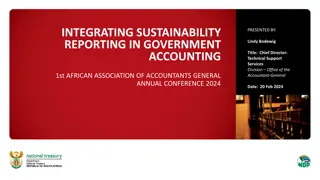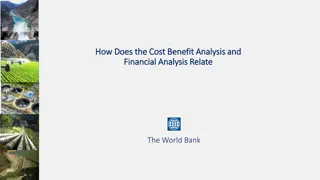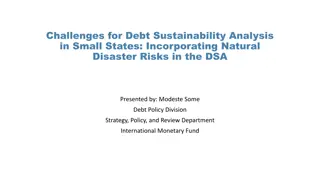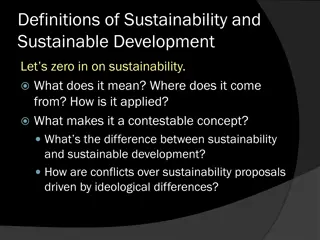Economic and Financial Sustainability
Sustainability in economic and financial decision-making is crucial. This content delves into the reality behind standard economic and finance theories, raising questions about the sustainability of our society. It highlights the critical role of human populations and demographic sustainability. Factors influencing sustainability, such as natural resources abundance and living standards, are discussed, along with the declining fertility rates in various populations. The content emphasizes the significance of sustainable practices in ensuring a stable future for our society.
Download Presentation

Please find below an Image/Link to download the presentation.
The content on the website is provided AS IS for your information and personal use only. It may not be sold, licensed, or shared on other websites without obtaining consent from the author.If you encounter any issues during the download, it is possible that the publisher has removed the file from their server.
You are allowed to download the files provided on this website for personal or commercial use, subject to the condition that they are used lawfully. All files are the property of their respective owners.
The content on the website is provided AS IS for your information and personal use only. It may not be sold, licensed, or shared on other websites without obtaining consent from the author.
E N D
Presentation Transcript
In standard economic theories, economy will grow indefinitely over time. There are two main branches in finance: corporate finance and investment theory. In corporate finance, the standard theory is MM theory. In MM theory, an investment is assumed to extend to perpetuity.
In investment theory, stock market are assumed to increase indefinitely over time. There is no sustainability problem in standard economic and finance theories. But what is the reality?
Sustainability has become a major concern in our economic and financial decision making How sustainable is our society? What signs we should look at on sustainability?
Sustainability can be understood from many different angles. Ultimately, in a human society, all sustainability rest on human populations. We will focus on the sustainability of human populations and its interaction with financial policies.
Demography is destiny Demography is destiny Auguste Comte (1789-1857) Ultimately, all sustainability measures depend on demographic sustainability.
Factors determining sustainability Abundance of natural resources Living standard Irrelevance of natural resources in a technology society? Case of Japan? All societies that have strong central governments have seen their fertilities dropped below replacement rate.
Children as the future of our society We often say children are the future of our society. How about the fertility rates in Canada? About 1.6. This is far below the replacement rate of 2.1.
Detailed consequences School enrolments keep declining in most school districts. In Prince George, student enrollment declined steadily in the first decade of the century. But it seems to stabilize in the past ten years. UNBC enrolment has been stagnant, far below the twelve thousand target.
Future work forces Health care costs Resilience to pandemics With an aging population, pool of workers will decline, health care costs will rise, the society becomes more vulnerable to pandemics.
More detailed analysis Fixed cost and sustainability Higher fixed cost system require larger market size to sustain itself. High school have higher fixed cost than elementary school. When mandatory education extends to high school, the minimal size of a sustainable community increases.
When a community cannot support a high school, young families start to move away. Later, the community cannot support an elementary school. More families move away. The community eventually disappear. Example, Hixon, which is between Prince George and Quesnel.
With higher fixed costs, population will move to big population centers. Cities become more populous and more popular. Small villages are vacated.
Why most economists are not concerned Economists mostly use GDP as the measure of health of the society. GDP is still growing in most wealthy countries Economists mostly live in population centers. They feel the environment becomes more crowded. So do majority of people.
The problems of Using GDP as the main measure The decline of fertility rate free up labor forces over the short term. More women join labor market. This generate short term economic growth. But over long term, labor supply will decline. Since it takes about 25 years from birth to work, it is only after 30 years the negative impacts of low fertility rates will show up in economic activities.
Monetization of society With the socialization of senior care and the decrease of family size, more and more senior care and kids care are monetized. GDP continue to grow, although the quantity and quality of social activities are declining.
Fertility rate, which is the return on human investment, is a much more fundamental parameter and is a leading indicator over GDP growth rate.
Examples If fertility is used as a measure of social health in Japan, you would have recognized its eventual decline in early 70s. However, even today, economists are still arguing about how past policy mistakes wreck Japanese economy and how a good policy can revive Japanese economy.
Even on the issue of fertility rate, Japanese governments depend on increasing taxes to support child care. For example, several years ago, Japanese government raised sales tax to provide free child care as a means to increase birth rate.
It is difficult for the government to acknowledge that big government is the problem, not the solution.
Europe If fertility is used as a measure of social health in Europe, you would be much less ambitious about expansive social engineering such as the creation of Euro zone. Instead, various countries will prepare for maintaining and simplifying their social structures. The attempts by European countries and others to save Euro will further drag down Europe and the world indefinitely, until the final collapse of the Euro and Euro zone.
China If fertility is used as a measure of social health in China today, policy makers would attempt to slow down instead of speed up economic growth, to avoid future economic collapse. Policymakers would have scraped the one child policy long ago.
Can one child policy be stopped when the population size becomes optimal , whatever that term means? In such a society, population structure, with mostly seniors and few young people, is hardly optimal.
Furthermore, policies will be more influenced by the needs of seniors than by the needs of young families in reproductive ages. This will continue to depress fertility over long term, as observed in countries that experience demographic transitions earlier.
Canada and BC If fertility is used as a measure of social health in Canada today, we would need to seriously rethink about our policies and social structures. We might stop burdening ourselves with things like carbon tax. We might start to reduce our health care cost instead of increasing it.
We might reduce pension deduction so young people can have more resources for more children.
Historically, the sharp decline of fertility is always the harbinger of decline of highly developed civilizations. However, there is a time lag between the decline of fertility and the decline of economic output. The initial decline of fertility reduces the ratio of dependents over workers, which actually speed up economic growth.
Why high tax policy always fails High tax policy always increases the tax burden of the working class. The government won t tax the wealthy class, for the wealthy class controls the tax policy. Tax policies always create loopholes for the wealthy to evade taxes. This discourage people from participating works.
US labor participation rate Labor participation rate 68.0 66.0 64.0 62.0 60.0 58.0 56.0 54.0 52.0 1950 1952 1955 1958 1961 1964 1967 1970 1973 1976 1979 1982 1985 1987 1990 1993 1996 1999 2002 2005 2008 2011 2014 2017 2020
With more and more women participating labor force, labor participating rate has been increasing steadily, peaked at 67.3% in 2000. Since then, labor participating rate has been slipping to around 62% in 2021.
A crude calculation of labor participation rate Labor participation rate is calculated based on the population over 16 years old. In US, the lifespan is about 80 years old. From 16 to 80, total number of years is 80 16 = 64 years. Assume on average, people work from 22 years old to 65, for a total of 43 years.
If everyone works, one would expect a labor participation rate to be 43/64 = 0.672 = 67.2 % This crude calculation is very close to the peak labor participation rate of 67.3% reached in 2000.
From Darwin, A most important obstacle in civilized countries to an increase in the number of men of a superior class has been strongly urged by Mr. Greg and Mr. Galton, namely, the fact that the very poor and reckless, who are often degraded by vice, almost invariably marry early, whilst the careful and frugal, who are generally otherwise virtuous, marry late in life, so that they may be able to support themselves and their children in comfort. Those who marry early produce with a given period not only a greater number of generations, but, as shewn by Dr. Duncan, they produce many more children. The children, moreover, that are born by mothers during the prime of life are heavier and larger, and therefore probably more vigorous, than those born at other periods.
Thus the reckless, degraded, and often vicious members of society, tend to increase at a quicker rate than the provident and generally virtuous members. Or as Mr. Greg puts the case: The careless, squalid, unaspiring Irishman multiplies like rabbits: the frugal, foreseeing, self-respecting, ambitious Scot, stern in his morality, spiritual in his faith, sagacious and disciplined in his intelligence, passed his best years in struggle and in celibacy, marries late, and leaves few behind him.
Given a land originally peopled by a thousand Saxons and a thousand Celts --- and in a dozen generations five-sixths of the population would be Celts, but five-sixths of the property, of the power, of the intellect, would belong to the one- sixth of Saxons that remained. In the eternal struggle for existence, it would be the inferior and less favoured race that had prevailed --- and prevailed by virtue not of its good qualities but of its faults.
Today's world Rich country. Low discounting, long education, late marriage, low marriage rate, low fertility. Poor country High discounting, short education, early marriage, high marriage rate, high fertility.
Inside a rich country such as Canada More educated: Low fertility Less educated: High fertility
advantages of high discount rate We normally notice many disadvantages of high discounting, such as poverty. But there are advantages: Enjoy now, More children
Disadvantage of low discount rate Low discount rate is often associated with farsightedness. However, we often are not as farsighted as the low discount rate demand. We get university education for the expected future payoff. However, many of us are not highly motivated to work hard. We delay our marriage and having children. We have few children in the end.
An Example Suppose our life span is 80 years old. For the first and last 20 years, we depend on others for our living. For the middle 40 years, we live on our own and possibly provide for others. Assume our current living standard consumes 8 unit of resources per year. During our working age, we obtain 15 unit of resource per year, for 40 years.
An Example (Continued) Calculate the amount of net resource, which is defined as the amount of resource we obtain during working age minus the amount of resource we consume during working age. This is the amount of resource available for next generation. Calculate the number of children we can support. Will population grow or decline in this society?
Consumption in first and last 20 years 8*40=320 unit of resource Resource extraction in 40 years of adult life 15*40 = 600 unit of resource Consumption in adult life 8*40 = 320 unit of resource
Net resource 600 320 = 280 unit of resource Number of children can be supported 280/320 = 7/8 < 1 Population declines.
Continued from the last question. Assume all other conditions remain same. But the living standard is lowered to 7 unit of resource per year. Recalculate and determine how many children each person can support. Will population grow or decline in this society?
Consumption in first and last 20 years 7*40=280 unit of resource Resource extraction in 40 years of adult life 15*40 = 600 unit of resource Consumption in adult life 7*40 = 280 unit of resource
Net resource 600 280 = 320 unit of resource Number of children can be supported 320/280 = 8/7 > 1 Population increases.
Comments When we try too hard to raise living standard, fertility drops below replacement rate. This high living standard is unsustainable.
Choice or necessity The decline of fertility is often interpreted as the choice of modern people. We would like to discuss how we use choices in general. When we drive, we have a choice to drive on the right side or left side of the road. But of course most of us choose to drive on the right side of the road. Otherwise, we will die soon.
We have a choice to show up at the final exam or not to show up at the final exam. But if we do not show up, we will fail the course. In general, we rationalize our necessity as our own choice. This makes us feel much better.
Lets get back to fertility. It is very expensive to raise children in modern society. We often need to send our children to hockey, soccer, ski, piano and many activities. They are very time consuming and costly. At the same time, modern careers require long term investment. If we have children early, it reduces our time to socialize with our colleagues and makes our schedule less flexible. We are less able to travel or perform field works for extended periods.























